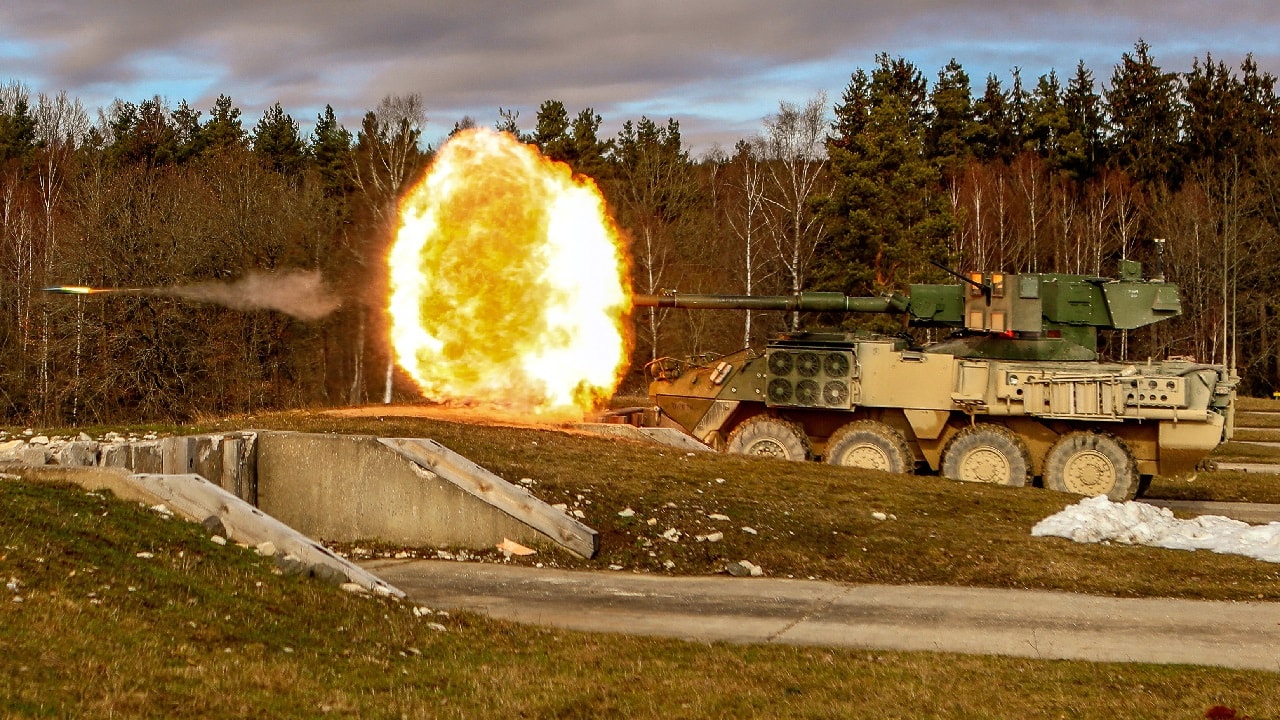The U.S. Army’s Stryker, a versatile combat vehicle, is getting a laser that can shoot down drones and other threats. The fast, wheeled-vehicle has many roles – one of them is for air defense artillery and this system can help protect soldiers in brigade combat teams. The laser conversion will happen in the next few weeks, the Army’s Rapid Capabilities and Critical Technologies Office said. This is an important development for the Army as the war in Ukraine has proven that Russian armored vehicles have suffered numerous losses and damages at the hands of drones – many of them commercial-off-the shelf quadcopters that drop grenades.
It Can Engage a Full Spectrum of Drones
This laser’s name is a mouthful. It’s called the Directed Energy-Maneuver Short-Range Air Defense system. This will be a 50 kilowatt laser designed to down drones that weigh from 20 pounds to 1,320 pounds. The laser can also engage and destroy rockets, mortars, and artillery.
Tactics for Engaging Targets Remain the Same
Lt. Gen. Neil Thurgood, head of the Rapid Capabilities and Critical Technologies Office, said the Army will not have to change the way it targets and engages drones or other projectiles. The targets, techniques, and procedures (TTPs) will remain the same. The Army has successfully tested the Stryker-mounted laser in two live fire events. It took six months of research and development to take out mortar rounds, but the rapid capabilities office was finally able to knock out these projectiles.
“The TPPs for firing a laser are almost like the TPPs for firing a bullet,” Thurgood said to Breaking Defense. “It’s just a bullet made out of light — that’s the only differences. The kill chain is the same.”
Get the Soldiers’ Feedback
The Army Rapid Capabilities and Critical Technologies Office looks at battlefield problems and investigates the greatest need, in this case, small drone attacks on armored vehicles. Then it aims for rapid prototyping. They integrate soldier feedback to get a prototype as quickly as possible.
Quick Timetable
“This has been an effort like no other,” said Colonel G. Scott McLeod, the program manager for the new laser. “We are building and delivering a brand new capability. This is not a modification or an upgrade. It took just 24 months for the combined government and industry team to design, integrate, and have it ready to perform in an operational environment.”
Aspects of Video Games Integrated
Input from soldiers was critical during the development process. Personnel asked for “video game controllers” to aim the laser. They also had 3D models of the Stryker to inspect the various components that went into the system. The directed energy system underwent a series of tests in August 2021 and then it took only 12 more months of efforts to get it deployed in the field.
Scratch One Priority Off the List
Battlefield lasers are one of the top 35 priorities for the Army and the service branch will likely take the lessons learned on this program to help out on other projects. The Army Futures Command is also responsible for the newfangled technology that will go to the troops in the coming years. One office under the Army Futures Command is the Army Applications Laboratory (AAL) – a center that works closely with civilian technology startups. AAL is housed in a civilian tech incubator in Austin, Texas. AAL puts out a need for technology to the civilian companies. It takes the leadership teams and engineers to the field and shows them what the problem is. Then AAL picks the startup that can deliver the goods.
The directed energy program, if it continues to successfully fire the “bullets made out of light,” could see deployment on Bradley Infantry Fighting Vehicles and Abrams tanks. This would better protect armored brigade combat teams on future battlefields. Lasers would then see wide adoption throughout the service and better protect soldiers from unmanned quadcopters that have become deadly in Ukraine.
Now serving as 1945’s Defense and National Security Editor, Brent M. Eastwood, PhD, is the author of Humans, Machines, and Data: Future Trends in Warfare. He is an Emerging Threats expert and former U.S. Army Infantry officer. You can follow him on Twitter @BMEastwood.

